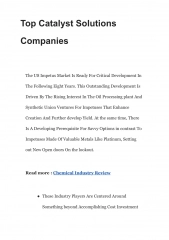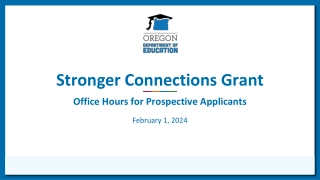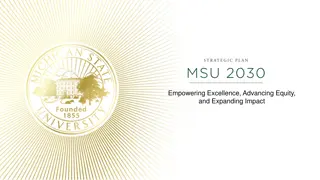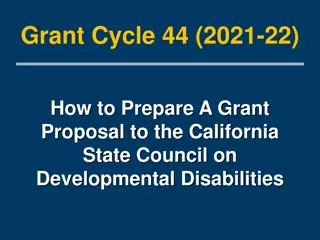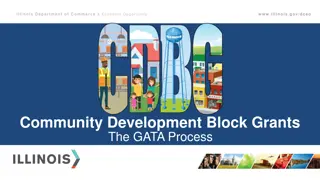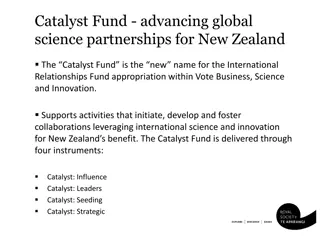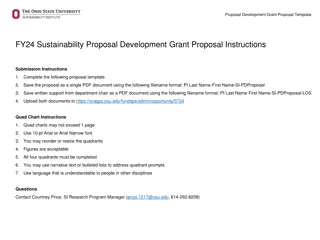WRITING AN EFFECTIVE EQUITY-THEMED CATALYST GRANT PROPOSAL
Presenting a grant proposal focusing on inequity to address important societal problems, with the goal of generating evidence and tools for equitable social change. The proposal explores the lack of care workers across Canada and aims to map out areas with disparities in access to care services.
Download Presentation

Please find below an Image/Link to download the presentation.
The content on the website is provided AS IS for your information and personal use only. It may not be sold, licensed, or shared on other websites without obtaining consent from the author.If you encounter any issues during the download, it is possible that the publisher has removed the file from their server.
You are allowed to download the files provided on this website for personal or commercial use, subject to the condition that they are used lawfully. All files are the property of their respective owners.
The content on the website is provided AS IS for your information and personal use only. It may not be sold, licensed, or shared on other websites without obtaining consent from the author.
E N D
Presentation Transcript
WRITING AN EFFECTIVE EQUITY-THEMED CATALYST GRANT PROPOSAL SHERRI KLASSEN ASSISTANT DIRECTOR, CENTRE FOR GLOBAL SOCIAL POLICY
GENERAL GOALS OF THE PROPOSAL TO PRESENT THE INTELLECTUAL PROBLEM(S) OR PUZZLE(S) TO PERSUADE THE REVIEWERS THAT THE PROBLEM IS IMPORTANT AND WORTH SOLVING TO DEMONSTRATE THAT YOU HAVE A GOOD PLAN TO SOLVE THE PROBLEM
"this theme encourages the generation of evidence (data and inference) and tools that enhance our understanding of inequity while supporting equitable social change. " THEMATIC PROGRAM IN INEQUITY
AXES OF INEQUITY Inequitable Access to Opportunities Economic Inequality Health Inequity Race/Ethnicity/Immigration Status Sex and Gender Early Life Disadvantage
EXAMPLE Mapping Home Care Deserts in Canada: using data from job ads to see where in Canada there are more or less home care workers in Canada. Geographic Inequity: if some places have more access than others to care services Health Inequity Outcomes Gender Inequity: If women bear the brunt of a shortage of care services Economic Inequity Outcomes
ELEMENTS OF THE CATALYST PROPOSAL Rationale, Goals & Objective Impact & Alignment Abstract Methods CVs
ABSTRACT - SAMPLE Mapping Home Care Deserts in Canada Care is a basic human right. While some forms of care are usually provided by family and loved ones, and others are provided by specialized health care workers, much of Canada s care infrastructure consists of paid home care workers, many operating in an informal economy. The availability of these workers, however, is not evenly spread across the country. Shortages of care workers in some regions results in inequitable access to care. This project seeks to identify Canada s home care deserts the geographical regions in which a lack of care workers results in a lack of care equity. To be inclusive of both certified personal support workers and unregulated individuals who provide care services, the study will mine data from online advertisements for care workers, using the number of advertisements and the length of time before positions are filled, in combination with Statistics Canada demographic and labour market data, to map the shortages of care workers across Canada. The project benefits from the expertise of Dr. F. Nightingale, who is a Professor of Industrial Relations and an expert in care human resources, and Dr. A. Lovelace whose computational skills and expertise in ARC-GIS will assure success of the webscraping and data mapping.
ABSTRACT MAPPING HOME CARE DESERTS Explicit statement about the importance of the project due to its relevance to the theme of inequity Care is a basic human right. While some forms of care are usually provided by family and loved ones, and others are provided by specialized health care workers, much of Canada s care infrastructure consists of paid home care workers, many operating in an informal economy. The availability of these workers, however, is not evenly spread across the country. Shortages of care workers in some regions results in inequitable access to care. This project seeks to identify Canada s home care deserts the geographical regions in which a lack of care workers results in a lack of care equity. To be inclusive of both certified personal support workers and unregulated individuals who provide care services, the study will mine data from online advertisements for care workers, using the number of advertisements and the length of time before positions are filled, in combination with Statistics Canada demographic and labour market data, to map the shortages of home care workers across Canada. The project benefits from the expertise of Dr. F. Nightingale, who is a Professor of Industrial Relations and an expert in care human resources, and Dr. A. Lovelace whose computational skills and expertise in ARC-GIS will assure success of the webscraping and data mapping.
ABSTRACT MAPPING HOME CARE DESERTS Clear statement outlining the overarching goal of the research Care is a basic human right. While some forms of care are usually provided by family and loved ones, and others are provided by specialized health care workers, much of Canada s care infrastructure consists of paid home care workers, many operating in an informal economy. The availability of these workers, however, is not evenly spread across the country. Shortages of care workers in some regions results in inequitable access to care. This project seeks to identify Canada s home care deserts the geographical regions in which a lack of care workers results in a lack of care equity. To be inclusive of both certified personal support workers and unregulated individuals who provide care services, the study will mine data from online advertisements for care workers, using the number of advertisements and the length of time before positions are filled, in combination with Statistics Canada demographic and labour market data, to map the shortages of home care workers across Canada. The project benefits from the expertise of Dr. F. Nightingale, who is a Professor of Industrial Relations and an expert in care human resources, and Dr. A. Lovelace whose computational skills and expertise in ARC-GIS will assure success of the webscraping and data mapping.
ABSTRACT MAPPING HOME CARE DESERTS Care is a basic human right. While some forms of care are usually provided by family and loved ones, and others are provided by specialized health care workers, much of Canada s care infrastructure consists of paid home care workers, many operating in an informal economy. The availability of these workers, however, is not evenly spread across the country. Shortages of care workers in some regions results in inequitable access to care. This project seeks to identify Canada s home care deserts the geographical regions in which a lack of care workers results in a lack of care equity. To be inclusive of both certified personal support workers and unregulated individuals who provide care services, the study will mine data from online advertisements for care workers, using the number of advertisements and the length of time before positions are filled, in combination with Statistics Canada demographic and labour market data, to map the shortages of home care workers across Canada. The project benefits from the expertise of Dr. F. Nightingale, who is a Professor of Industrial Relations and an expert in care human resources, and Dr. A. Lovelace whose computational skills and expertise in ARC- GIS will assure success of the webscraping and data mapping. A few sentences about methods and expertise
RATIONALE, GOALS AND OBJECTIVE: 1/3 PAGE Similar to the abstract but with more of a focus on the goals and importance of the project One sentence on the importance for societal equity 2-4 sentences outlining the overall goal and specific objectives
RATIONALE, GOALS AND OBJECTIVE SAMPLE FROM MONICA ALEXANDER, SSHRC INSIGHT DEVELOPMENT GRANT, USING FACEBOOK DATA TO MEASURE AND UNDERSTAND INTERNATIONAL MIGRATION PATTERNS IN CANADA
RATIONALE, GOALS AND OBJECTIVES - SAMPLE Despite the importance of migration as a driver of social inequity, inadequate data has stymied researchers' efforts to adequately understand migration and its relation to inequity. The current data available on international migrants either lack the granularity of information required to fully understand migration trends, or do not provide up-to-date trends. To overcome these issues, this project proposes using Facebook data to produce estimates and short term projections of migration flows in Canada, to better understand the demographic and socioeconomic characteristics and outcomes of migrants. In particular, the research asks: What is the current composition of migrants by place of origin for each province, and how are these compositions projected to change in the short term? What is the age and sex profile of international migrants by province, and how is it evolving in the short term? What are these migrants work and education outcomes, and how do these characteristics vary across age and place of origin? Estimates from this project will not only be useful in tracking migration trends, but also in helping to understand the work outcomes of migrants to Canada, providing an indication of employment inequities experienced by migrants and policy solutions that can assist in mitigating them. 1. 2. 3.
First sentence that points to the inequity issue and highlights the problem. RATIONALE, GOALS AND OBJECTIVES - SAMPLE Despite the importance of migration as a driver of social inequity, inadequate data has stymied researchers' efforts to adequately understand migration and its relation to inequity. The current data available on international migrants either lack the granularity of information required to fully understand migration trends, or do not provide up-to-date trends. To overcome these issues, this project proposes using Facebook data to produce estimates and short term projections of migration flows in Canada, to better understand the demographic and socioeconomic characteristics and outcomes of migrants. In particular, the research asks: What is the current composition of migrants by place of origin for each province, and how are these compositions projected to change in the short term? What is the age and sex profile of international migrants by province, and how is it evolving in the short term? What are these migrants work and education outcomes, and how do these characteristics vary across age and place of origin? Estimates from this project will not only be useful in tracking migration trends, but also in helping to understand the work outcomes of migrants to Canada, providing an indication of employment inequities experienced by migrants and policy solutions that can assist in mitigating them. 1. 2. 3.
RATIONALE, GOALS AND OBJECTIVES - SAMPLE Despite the importance of migration as a driver of social inequity, inadequate data has stymied researchers' efforts to adequately understand migration and its relation to inequity. The current data available on international migrants either lack the granularity of information required to fully understand migration trends, or do not provide up-to-date trends. To overcome these issues, this project proposes using Facebook data to produce estimates and short term projections of migration flows in Canada, to better understand the demographic and socioeconomic characteristics and outcomes of migrants. In particular, the research asks: What is the current composition of migrants by place of origin for each province, and how are these compositions projected to change in the short term? What is the age and sex profile of international migrants by province, and how is it evolving in the short term? What are these migrants work and education outcomes, and how do these characteristics vary across age and place of origin? Estimates from this project will not only be useful in tracking migration trends, but also in helping to understand the work outcomes of migrants to Canada, providing an indication of employment inequities experienced by migrants and policy solutions that can assist in mitigating them. 1. Final sentence provides more specificity about the inequities studies and possible solutions that could emerge from the research 2. 3.
IMPACT AND ALIGNMENT 2/3 PAGE = BETWEEN 330 AND 400 WORDS OR 3-4 SHORT PARAGRAPHS 1 2 3 Brief literature review Demonstrate the project s alignment to the social inequities theme which kind of inequity Outline the potential for social impact
IMPACT AND ALIGNMENT SAMPLE OUTLINE how does the topic relate to societal inequality? 1. are there intersecting inequities? OR (if not), detail more specifically how the specific research objectives are important for understanding inequity 2. how big/urgent a problem is this? 3. what kind of solutions do you envision coming out of this research? 4.
IMPACT & ALIGNMENT SAMPLE As Canada s population ages, access to care is fast becoming a new axis of inequality. (paragraph describing how uneven access to home care directly results in health and wellness inequity) In addition to inequitable health and wellness outcomes, a shortage of home care services also indirectly results in gender-based economic inequity...(paragraph discussing the gender inequity based on women leaving workforce for care) Statistics Canada found that in 2016 just over one third of Canadian adults with home care needs were unable to access the services that they required...(paragraph outlining urgency of the question) By identifying the regions with staffing shortages, this research will provide research findings that can help identify locations in need of targeted interventions to recruit and train more workers, improve pay and working conditions to assist in recruiting and retaining care workers, and strategize for localized solutions. (paragraph about impact)
WRITING A LIT REVIEW WITHOUT CITATIONS Statistics Canada found that in 2016 just over one third of Canadian adults with home care needs were unable to access the services that they required. Drawing on Pearlin s 1981 Stress Process Model, considerable research has shown how the impacts of early life disadvantage can be buffered by positive social support networks.
Present the methodological challenge(s) at the beginning, with a statement on how you will resolve it. METHODS Often (but not always) helpful to write a broad overview paragraph and then follow this with paragraphs that outline the activities chronologically Describe the data sources Outline the data collection techniques 1 PAGE = ABOUT 4 PARAGRAPHS Analysis maybe ending with knowledge translation Use the future tense, first person, active voice ("I/we will collect data by..." not "data would be collected by..."
Methods Sample Data sparsity issues cause difficulties for understanding Canada s migration patterns. This project innovates by using social media to build timely estimates of international migration in Canada. Since Facebook users are not representative of the broader population, we will then model to adjust the data. Data Collection. My student and I will extract information from Facebook s Advertising Platform to create a database of migrant populations and characteristics. Specifically, we will gather information including the following characteristics: sex; five-year age group; country of origin (defined as expats from country X , available for 90 countries); education (with categories including: in college, in high school, in graduate school, college degree, graduate degree, high school graduate); and occupational industry (e.g., sales, business and finance, medical, cleaning and maintenance services, etc.). Education and Employment are particularly important for understanding inequity outcomes. Once all desired characteristics are selected, the platform gives an estimate of the 'potential reach' (monthly active users) of the advertisement to this subgroup. We will use these estimates of potential reach by each migrant subgroup to build a database of migrant information. In order to automate data extraction from the advertising platform, we will write a script in the Python programming language which calls Facebook s API and return estimates of monthly active users over an 18-month period. As well as being freely available, these data have the added benefit of being aggregated at the population level, thus individual people remain de-identified. Statistical Model. As outlined in the figure, we will use a Bayesian hierarchical model, allowing different data sources to be combined in the one estimation framework. Additionally, the use of a Bayesian model allows us to incorporate different sources of uncertainty in each of the Facebook and Census datasets, and levels of uncertainty (confidence intervals) are easily obtainable around the resulting estimates and projections. Statistical The methodology is broadly designed as follows. First, we will model the Facebook data to adjust for bias based on calibration with the Canadian Census. Second, we will construct a time series model based on historical trends in the Census data. The model will also account for spatial correlation and pool geographic information across space. The two steps are combined within the one framework. The result of the statistical modeling process are estimates and short-term projects of international migrant numbers by key demographic and socioeconomic groups. Knowledge Dissemination and Translation. My student and I will publish three academic articles from this research two relating to the empirical findings and one focusing on the methodological innovation. We will also write plain language summaries of the findings and use the co-applicants' extensive networks in the policy sector to ensure that relevant federal and provincial policymakers are aware of the research findings and their implications for developing programs that eliminate inequitable access to opportunities for professional advancement as experienced by international migrants.
Methods Sample Data sparsity issues cause difficulties for understanding Canada s migration patterns. This project innovates by using social media to build timely estimates of international migration in Canada. Since Facebook users are not representative of the broader population, we will then model to adjust the data. Data Collection. My student and I will extract information from Facebook s Advertising Platform to create a database of migrant populations and characteristics. Specifically, we will gather information including the following characteristics: sex; five-year age group; country of origin (defined as expats from country X , available for 90 countries); education (with categories including: in college, in high school, in graduate school, college degree, graduate degree, high school graduate); and occupational industry (e.g., sales, business and finance, medical, cleaning and maintenance services, etc.). Education and Employment are particularly important for understanding inequity outcomes. Once all desired characteristics are selected, the platform gives an estimate of the 'potential reach' (monthly active users) of the advertisement to this subgroup. We will use these estimates of potential reach by each migrant subgroup to build a database of migrant information. In order to automate data extraction from the advertising platform, we will write a script in the Python programming language which calls Facebook s API and return estimates of monthly active users over an 18-month period. As well as being freely available, these data have the added benefit of being aggregated at the population level, thus individual people remain de-identified. Statistical Model. As outlined in the figure, we will use a Bayesian hierarchical model, allowing different data sources to be combined in the one estimation framework. Additionally, the use of a Bayesian model allows us to incorporate different sources of uncertainty in each of the Facebook and Census datasets, and levels of uncertainty (confidence intervals) are easily obtainable around the resulting estimates and projections. The methodology is broadly designed as follows. First, we will model the Facebook data to adjust for bias based on calibration with the Canadian Census. Second, we will construct a time series model based on historical trends in the Census data. The model will also account for spatial correlation and pool geographic information across space. The two steps are combined within the one framework. The result of the statistical modeling process are estimates and short-term projects of international migrant numbers by key demographic and socioeconomic groups. Knowledge Dissemination and Translation. My student and I will publish three academic articles from this research two relating to the empirical findings and one focusing on the methodological innovation. We will also write plain language summaries of the findings and use the co-applicants' extensive networks in the policy sector to ensure that relevant federal and provincial policymakers are aware of the research findings and their implications for developing programs that eliminate inequitable access to opportunities for professional advancement as experienced by international migrants.
SUMMARY Consider: how does your research question (or the problem that you are solving) relate to the drivers of social inequity State the connection explicitly and use previous research to show that it is an important question that will shed light on an aspect of inequity Use the methods to show that you have a plan that will solve the problem and help reduce inequities or ameliorate their negative impacts
RESIDENTIAL SEGREGATION IN KITCHENER-WATERLOO Research Question: How have residential neighbourhoods changed in KW since the tech boom? Could be ethnic enclaves growing; fewer opportunities for advancement, access to neighbourhood resources - Could be socio-economic shifts gentrifying neighbourhoods pushing out the marginalized - Could be comparing to existing literature focused on large cities is there greater inequity/fewer opportunities or access to resources in small cities? -
CHILDHOOD EXPOSURE TO AIR POLLUTANTS Research Question: How uneven are children s exposure to air pollutants and how does it matter? Suggest focusing in on one or two outcomes depending upon data access - Remember to look at intersecting inequities if poor regions also have more air pollutants, then there could be different vectors maybe combining -
POLITICAL TRENDS AND EGALITARIAN INHERITANCE PATTERNS IN COLONIAL FRANCE Research Question: Did the presence of ideologies of political equality result in more equitable inheritance patterns in Haiti than in New France? Focus on enduring importance of inheritance in perpetuating economic inequity - Posit the plausibility of the comparison and what it can tell us about inheritance as a historical driver of inequity/ political change as a force that can ameliorate it -
IMPACT & ALIGNMENT SAMPLE (HOME CARE DESERTS) As Canada s population ages, access to care is fast becoming a new axis of inequality. Uneven access to health care services results in inequitable social and health outcomes, as those who cannot access services may miss out on beneficial treatments. Home care services from service providers people who provide assistance with tasks of daily living such as personal hygiene, housekeeping, meal preparation, shopping and transportation also help to relieve stress and allow individuals in need of care to live independently with dignity. In some jurisdictions, such services are unavailable or unaffordable, resulting in inequitable experiences of aging or dealing with chronic illness. In addition to inequitable health and wellness outcomes, a shortage of home care services also indirectly results in gender-based economic inequity. Where paid services are inaccessible, individuals with needs typically rely upon female family members to provide support as unpaid, familial labour. Unpaid caregiving is one of the greatest barriers to women s social and economic advancement. Time Use survey analyses have shown that women contribute the vast majority of unpaid carework (cite). The unequal distribution of care responsibilities contributes to the gender wage gap, shorter paid working hours, reduced employment and missed career advancement opportunities (cite). Statistics Canada found that in 2016 just over one third of Canadian adults with home care needs were unable to access the services that they required. Data from the Canadian Community Health Survey (CCHS) identified availability of access and variation across jurisdictions as key barriers to home care. While home care includes both health care workers and support services, the CCHS showed that the greatest difficulties related to the availability of support workers (StatsCan 2018). Home care is not covered by the Canada Health Act and is, instead, the responsibility of the provinces with different jurisdictions paying for different services. At present it is uncertain to what degree the variations across the country are a result of jurisdictional differences and how much is due to staffing shortages. By identifying the regions with staffing shortages, this research will provide research findings that can help identify locations in need of targeted interventions to recruit and train more workers, improve pay and working conditions to assist in recruiting and retaining care workers, and strategize for localized solutions.


